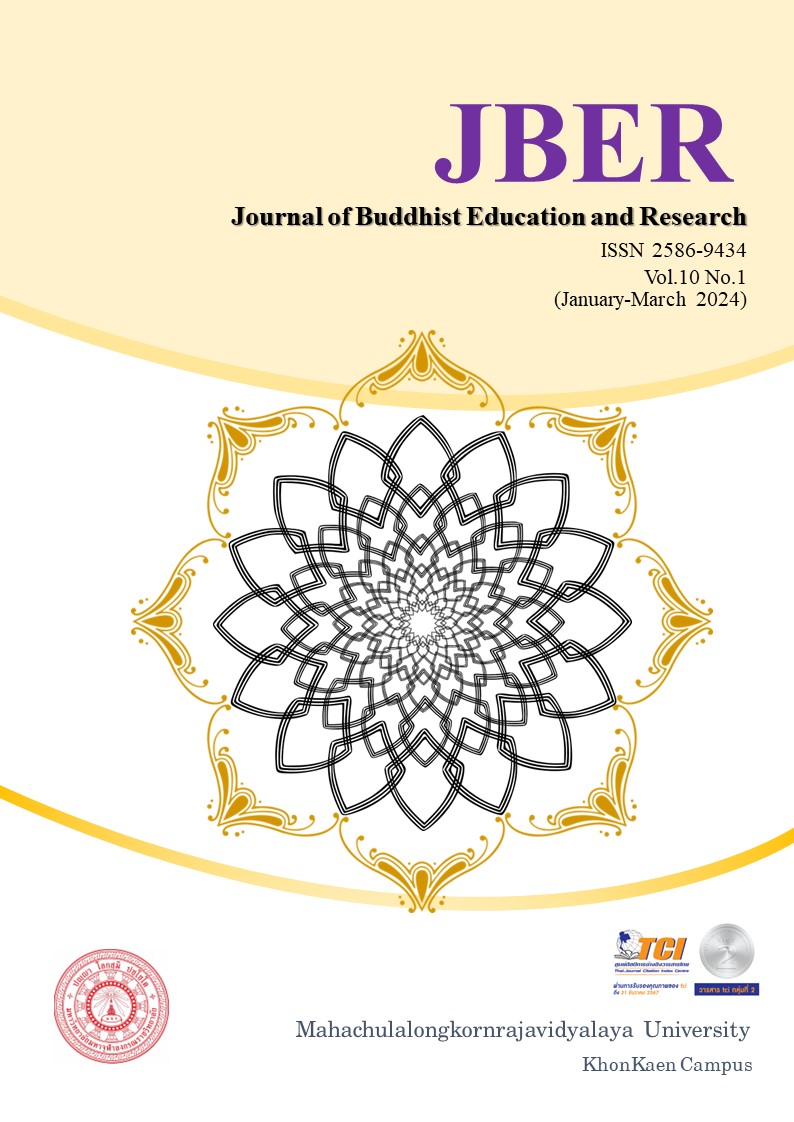THE EFFECTS OF USING MATHEMATICS PROJECT BASED LEARNING AND MODELING ON MATHEMATICAL CONNECTION ABILITY IN VOLUME FOR GRADE 9 STUDENTS
Keywords:
Keywords: Project-based learning with modeling, mathematical connection abilityAbstract
Abstract
The research aims to 1) Study the guideline for learning activities based on project-based learning and modeling to enhance mathematical connection ability for grade 9 students 2) Study the effect of learning activities based on project-based learning and modeling on mathematical connection ability for grade 9 students. The target group is 36 students in a secondary school in Kamphaeng Phet Province. The researcher applied classroom action research for 3 cycles. Which were totally 12 periods. The research tools were 1) lesson plans 2) reflection form 3) activity sheets 4) a test of connection skill in volume of three-dimensional shapes. The data were analyzed by content analysis and analytic scoring. The findings were as follows:
1) Learning activities based on project-based learning with modeling to enhance mathematical connection ability for grade 9 students should be emphasized that teacher should be a facilitator to guide students in finding the project topic and originality for doing project. Moreover teacher should, follow up on group activities for more information and understanding problem situation in the real life.
2) Most of students can connect between mathematics and mathematics,between mathematics and others, and between mathematics and real-life in very good level. They can choose and define topics, situations, or problems with the volume of three-dimensional shapes that are relevant to real life and they can solve problems reasonably
References
เอกสารอ้างอิง : References
กระทรวงศึกษาธิการ. (2551). หลักสูตรแกนกลางการศึกษาขั้นพื้นฐาน พุทธศักราช 2551. กรุงเทพมหานคร: โรงพิมพ์ชุมนุมสหกรณ์การเกษตรแห่งประเทศไทย.
จิราภรณ์ ทัพซ้าย. (2564). STEM Education เพื่อพัฒนาสมรรถนะผู้เรียนในศตวรรษที่ 21. Journal of Buddhist Education and Research . 7(2). 288-299.
ทิศนา แขมมณี. (2563). ศาสตร์การสอน:องค์ความรู้เพื่อการจัดกระบวนการเรียนรู้ที่มีประสิทธิภาพ. กรุงเทพฯ: สำนักพิมพ์จุฬาลงกรณ์มหาวิทยาลัย.
ธนิษฐา โพธิ์อ่อง. (2564). การจัดกิจกรรมการเรียนรู้คณิตศาสตร์ตามแนวคิดโครงงานเป็นฐานเพื่อ พัฒนาความคิดสร้างสรรค์ เรื่อง ปริมาตรและความจุของทรงสี่เหลี่ยมมุมฉาก ของผู้เรียนชั้น ประถมศึกษาปีที่ 5 (วิทยานิพนธ์ปริญญามหาบัณฑิต). พิษณุโลก: คณะศึกษาศาสตร์.
พรรณวิไล ชมชิด. (2552). การจัดการเรียนการสอนวิทยาศาสตร์โดยใช้แบบจำลอง. นิตยสาร สสวท, 38(163), 33-34.
ภรทิพย์ สุภัทรชัยวงศ์. (2556). การจัดกิจกรรมการเรียนรู้โดยใช้แบบจำลองเป็นฐานเพื่อพัฒนาแบบจำลอง ทางความคิดเรื่องโครงสร้างอะตอมและความเข้าใจธรรมชาติแบบจำลองของผู้เรียนชั้นมัธยมศึกษา ปีที่ 4 (วิทยานิพนธ์ปริญญามหาบัณฑิต). กรุงเทพฯ: มหาวิทยาลัยเกษตรศาสตร์.
ศศิธร แม้นสงวน. (2556). พฤติกรรมการสอนคณิตศาสตร์ 2 (พิมพ์ครั้งที่ 2). กรุงเทพฯ: สำนักพิมพ์ มหาวิทยาลัยรามคำแหง.
สถาบันส่งเสริมการสอนวิทยาศาสตร์และเทคโนโลยี. (2555 ข). การวัดและประเมินผลคณิตศาสตร์. กรุงเทพฯ: ซีเอ็ดยูเคชั่น.
สิรินภา กิจเกื้อกูล. (2557). การจัดการเรียนรู้วิทยาศาสตร์ ทิศทางสำหรับครูศตวรรษที่ 21. เพชรบูรณ์: จุลดิ สการพิมพ์.
สิรินทรา มินทะชัติ. (2556). ผลของการจัดกิจกรรมการเรียนรู้โดยใช้ปัญหาเป็นฐาน (Problem- BasedLearning) เรื่อง พื้นที่ผิวและปริมาตร ที่มีผลต่อความสามารถในการคิดวิเคราะห์ และ ความสามารถในการให้เหตุผลทางคณิตศาสตร์ของผู้เรียนชั้นมัธยมศึกษาปีที่ 3. กรุงเทพ: มหาวิทยาลัยศรีนครินทรวิโรฒ.
อังคณา ตุงคะสมิต. (2559). สังคมศึกษาในโลกอาเซียน Social studies in ASEAN Community. ขอนแก่น: โรงพิมพ์มหาวิทยาลัยขอนแก่น.
อัมพร ม้าคนอง. (2553). ทักษะและกระบวนการทางคณิตศาสตร์:การพัฒนาเพื่อพัฒนาการ. กรุงเทพฯ: โรง พิมพ์แห่งจุฬาลงกรณ์มหาวิทยาลัย.
อารยา ควัฒน์กุล. (2558). ผลการจัดกิจกรรมการเรียนรู้วิชาเคมี เรื่อง สารชีวโมเลกุลด้วยการเรียนรู้โดยใช้ แบบจำลองเป็นฐานเพื่อพัฒนามโนทัศน์ทางวิทยาศาสตร์ และความสามารถในการสร้าง แบบจำลอง ทางวิทยาศาสตร์ สำหรับผู้เรียนชั้นมัธยมศึกษาปีที่ 6. วารสารศึกษาศาสตร์ มหาวิทยาลัย บูรพา 26(2), 42-55.
Dossey, J. A. (2002). Mathematics Methods and Modeling for Today's Mathematics Classroom; A Contemporary Approach to Teaching Grade 7-12. Pecific Grove,CA: Brooks Cole.
Gilbert, J.K., & C.J. Boulter. (2000). Deverloping models in science education. New York: Kluwer Acadamic Publishers.
Harrison, A. G. & D. F. Treagust. (2000). Learning about atom, molecules, and chemical bonds: A case study of multiple-model use in grade 11 chemistry. Science Education, 84(13), 352-381.
Hasbi, M., Lukito, A., Sulaiman, R., & Muzaini, M. (2019). Improving the Mathematical Connection Ability of Middle-School Students through Realistic Mathematics Approach. Journal of Mathematical Pedagogy (JoMP), 1(1), 37-46.
National Council of Teachers of Mathematics (NCTM). (2000). Principles and Standards for School Mathematics. Virginia, Reston.





